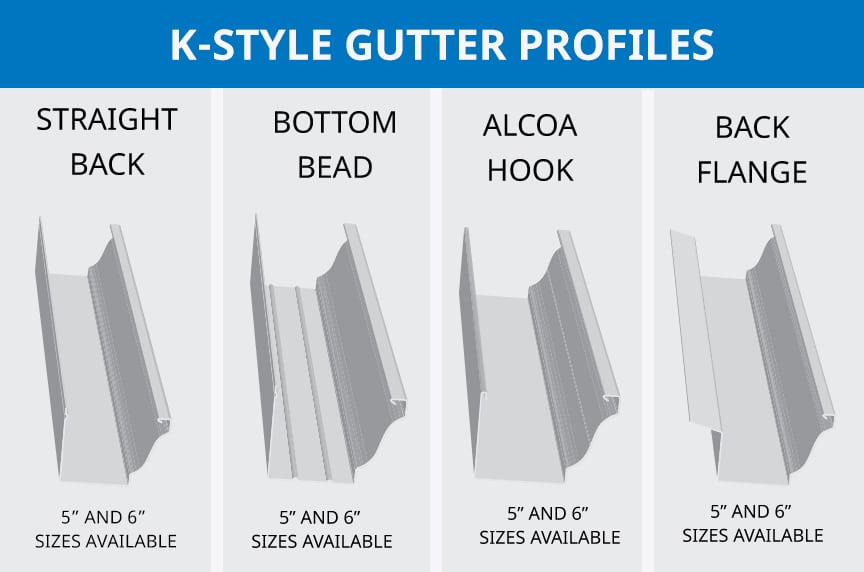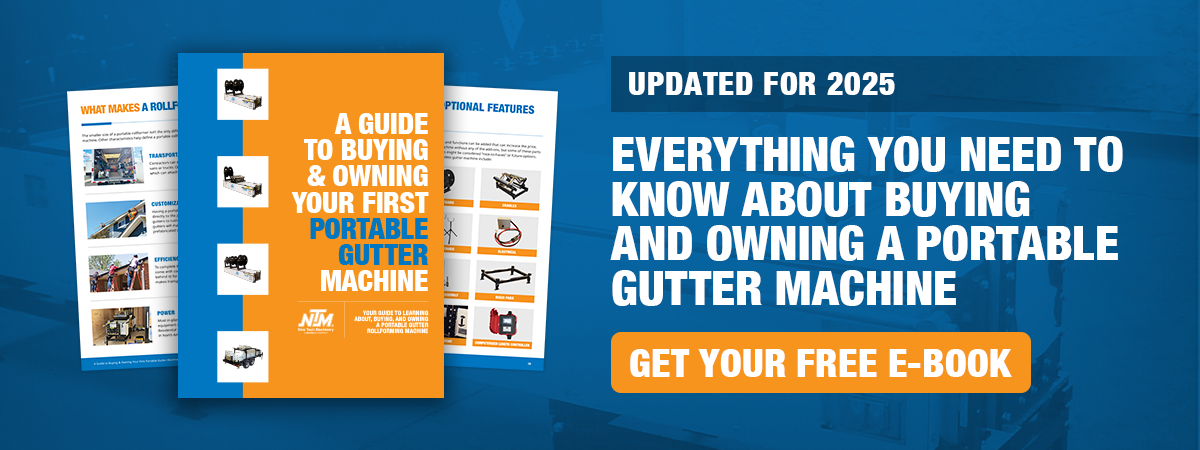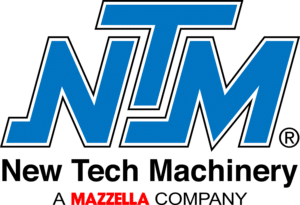Why Choose a Mach II 6″ Portable Gutter Machine?
New Tech Machinery’s (NTM) 6-inch Mach II machine is the big brother to our 5-inch model. Prototyped in 1991 and first delivered in 1994, the Mach II has seen a few tweaks, but its separate polyurethane drive and forming rollers, and rugged design are still built on that original, field-proven model.
When to Choose 6” K-Style Gutters
K-Style is the most popular type of gutter in residences and buildings across the country and beyond. The most common K-Style gutter sizes are 5″ and 6″. It may not sound like a big difference between the two, but a 6” holds nearly 50% more water than its smaller counterpart. That’s a huge advantage in areas with heavy rain, strong storms, and ice and snow.
Key Considerations:
- Roof plane: The real surface area of each roof section, measured along the slope, determines the size of the roof. Larger roofs will have greater run-off and require a larger gutter. A roof over 1,400 sq. ft. requires a 6” gutter in most areas.
- Roof pitch: A 400-800 sq. ft. roof with a steep enough pitch may require a 6” gutter due to the speed of water runoff. So, while the plane is one determiner of gutter size, pitch also must be factored in to avoid overflow.
- Climate: In a dry climate, a 5” gutter is fine for any size roof. However, even an occasional strong storm can damage landscape if the gutters overflow, so if it’s a dry area with seasonal strong storms, a 6” gutter may be the better choice. If your region receives 30” or more rain every year, the 6” is a shoo-in.
- Because 6” gutters hold almost double the amount of water as 5”, they can handle more ice, snow, leaves, twigs, etc. Their larger capacity helps facilitate the movement of water to the downspouts. Also, the downspouts on a 6″ gutter will be larger–3″ x 4″–wide enough to accommodate most debris.
- Appearance: If the house has a small fascia board, the 6” gutter may stick out. You don’t want the rain flowing over the overhang, either, so make sure the gutter fits the roofline.
- Material: 6” gutters are heavier and larger than 5”, so a weak material may not serve the purpose if it doesn’t hold up to storms. Aluminum is common due to its low cost and durability in hot and cold conditions; however, in some regions, gutter contractors may only install steel, galvanized steel, or copper due to their strength. Steel and copper require more labor and come with higher price tags, so if cost is a consideration, aluminum may be the best option for many homeowners.

NTM’s Mach II 6” Portable Gutter Machine
Configurations
| Mach II Configurations | Description |
| Top-mount reels (1-3) | Mix freely with cradles; the first cradle must sit ahead of any reel so coil feeds cleanly. |
| Coil cradles (0-3) | Ideal for heavier steel or copper loads. |
| Economy model | Available with or without the manual shear. |
Materials & gauges the 6″ Mach II will run
| Material (15″ width) | Gauge / weight |
| Painted or galvanized steel | 30 ga. – 24 ga. |
| Painted aluminum | 0.019″ – 0.032″ |
| Copper (¾-hard) | 16 oz. – 20 oz. |

Best Mach II Accessories
Having the right accessories can make your operation more efficient. Knowing the difference in capacity between a cradle (weight up to 400 lbs.) and a reel (weight up to 1,000 lbs.) may be important when it comes to the size of the job.
Listed below are popular accessories. For a full list, click here.
- EZ-Counter Computerized Length Controller—Program up to 50 lengths, track material, offer miter options on all gutter machines, operate in feet and inches, inches only, or millimeters, and operate as an Easy-touch screen.
- Hook assembly – hems the back flange for hidden hangers
- Bottom-bead assembly – two decorative ribs down the gutter floor (also helps reduce oil-canning)
- Run-out stands – essential for supporting long gutter sections as they exit the machine
- Transfer racks—Transfer racks are a great accessory for your gutter machine if you’re using reels. They make transferring loaded coils from one turnstile reel stand to another easier and faster.
Why Do Contractors Move Up to a 6″ Gutter Machine?
| Benefit | What it means in the field | Key data |
| ~40 – 50 % more water capacity | Handles cloud-burst rainfall without overflow | 6″ K-style holds ~2 gal/ft vs. 1.2 gal/ft for 5″ |
| Bigger 3 × 4 in downspouts | Faster drainage, less clogging from leaves & needles | Larger outlet + wider trough reduces debris buildup |
| Better for large, steep, or metal roofs | Fast-moving runoff stays inside the gutter instead of overshooting | Steep-pitch and smooth metal roofs often overwhelm 5″ systems |
| Fewer downspouts on long runs | Cleaner facades and lower install time | Wide trough lets you extend downspout spacing |
| Minimal cost bump | Typically $0.50–$1.00 more per foot—an easy upsell | Industry pricing averages |
Where Are 6″ gutters in highest demand?
| Region | Climate driver | What local pros say |
| Florida & Gulf Coast | Frequent, high-volume thunderstorms | 6-in gutters manage high volumes of water and protect fascia from overflow. Heavy materials like steel or galvanized steel can endure high winds. |
| Pacific Northwest | Long rainy seasons, 70-100 in/yr in spots | An area that gets a lot of rainfall, 6″-in K- gutters can handle the runoff. |
| Great Plains & Midwest | Intense summer downpours & large roof planes | Temperate, rain-prone regions generally need 6″ gutters, even if rain isn’t year-round. 30+ inches of rain per year is a good indicator. |
| Upper Midwest / New England | Wide fascia boards & steep hip roofs | Local installers recommend 6-in for roofs >1,400 sq ft or long shingle overhangs. That aside, their green summers depend on lots of spring rain. |

Key Takeaways for metal-roof and gutter pros
If your service area sees regular heavy rain—or you’re bidding metal-roof projects with steep pitches—a 6″ gutter profile is fast becoming the new residential standard. Pairing NTM’s Mach II 6″ machine with its quick-swap accessories lets you:
- Keep production in-house instead of buying factory-made gutters.
- Upsell premium water-management on every roof replacement.
- Pivot between 5″ and 6″ jobs simply by rolling the right machine to site.
Ready to spec your machine? Grab NTM’s downloadable gutter-machine guide for current pricing, financing, and lead times, and keep your crews ahead of the rain.
Want to speak with our NTM gutter machine account specialist? Click the button below.

